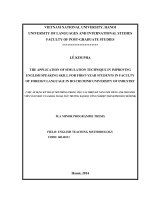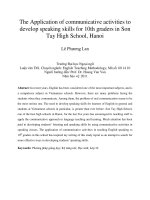Lesson19- The Application of Electricity on Board
Bạn đang xem bản rút gọn của tài liệu. Xem và tải ngay bản đầy đủ của tài liệu tại đây (143.04 KB, 5 trang )
Lesson19- The Application of Electricity on Board
1. Electrical Drive for Machinery
The electrical drive system principally contains motor, drive mechanism and
control unit. Among them, the motor is cast for the part of a prime mover in the electrical
drive system, whose function is to transform electrical energy into mechanical energy and
whose types and capacity depend on the requirements of the relevant working machinery.
Both motors and working machinery are either directly connected or joined together into
one unit by a speed reduction drive mechanism. With regard to the control unit, it has
been developing rapidly from a simple relay contactor to a complicated control system of
various automatic components.
In fact, there is a lot of aux. machinery on board, which is generally of electrical
drive and electromagnetic contactor control. For some aux. machinery, however, a few
additional control components are adopted to relieve the crew of the routine operation
and maintenance, such as pressure relay, temperature relay, level relay, etc.
In addition, the anchoring and mooring equipment is also common deck machinery.
Electrical-driven anchor windlasses and anchor winches are now widely employed. It is
easy enough to lower an anchor by gravity, but there are several stages for the anchor
retaking that are of varied speeds. Therefore, a motor will run at a higher speed if the load
is light, and has to run at a minimum speed when the anchor approaches the hawsepipe.
To fulfill the mission, a control circuit of relay contactors with the master controller is to
be arranged to regulate the motor speed.
2. The Electric Steering Gear System
The three types for the electric steering gear system are as follows:
2.1. Hand Steering
By hand steering, its control circuit is normally to be of relay contactors. In order
to safeguard the reliable operation of the steering gear, two motors are to be provided,
with any one of them in service and the other in the state of stand-by. The hand steering
system to be supplied with electricity from two feed circuits port and starboard. And the
steering gear motor to be controlled by a hand lever fitted on the maneuvering console in
the wheel-house and the hand lever possesses three different positions, left, middle (or nil
) and right. The hand steering is widely employed on small and medium ships, while on
large ships it serves as the emergency steering.
2. 2. Wheel Steering
Wheel steering has found a wide application in various types of vessels, the
characteristic of which is that the steering wheel turns towards either port or starboard
with a certain rudder angle in accordance with the relevant instructions. Accordingly, the
rudder will follow the steering wheel with the same rudder angle. For instance, if the
steering wheel turns to port at 5 degrees, the rudder will follow the steering wheel and
stop at 5 degrees port; and if the steering wheel turns to starboard at 10 degrees; the
rudder will also go after the steering wheel and come to a stop at 10 degrees starboard. To
cut the long story short, the position of the steering wheel shall always correspond to the
rudder angle. To achieve this, it is necessary to add synchronous followers to the control
circuit.
2. 3. Automatic Steering
During voyage, a vessel will deviate from its set course owing to the influence of
such external interfering moments as waves and so on. So the resultant yaw will be
different both in its magnitude and in its direction corresponding to the above moments.
The function of automatic steering is to maintain that a vessel will automatically keep to
a straight line along its given course. The signals of instruction for the automatic steering
may derive either from a directional finder or from a gyro compass, or are to be obtained
by making use of the earth magnetic field directly, with the gyro compass acting as the
most common source of signals.
3. Illumination
Ship's illumination includes cabin lighting, deck lighting, search light,
navigational light, signal light and portable light of low voltage and so forth.
In respect of the circuits of ship's illumination, there are normal lighting circuit,
emergency lighting circuit and temporary emergency lighting circuit.
As the power system works smoothly, the power supply of illumination comes
from the normal lighting circuit through lighting distribution boxes that are arranged at
various positions onboard. But, please note that, the power supply for the outdoor
illumination shall originate from the distribution box fitted in the wheel-house so that it
can be easily cut off from the wheel house for the sake of convenient night voyage.
When the main power station breaks down, the power supply of the emergency
lighting to be received from the emergency generating set through the emergency lighting
circuit. Whereas the temporary emergency lighting will be supplied with power by
battery units, and its circuit can be closed automatically if the main network or
emergency network fails, or the voltage drops to 40 % of the rated value. On the contrary,
the circuit will be open automatically as well when the main network or emergency
network restores its voltage. The temporary emergency lighting serves as a supplemental
means to instantaneous shortage of electricity when the normal power supply is switched
over to the emergency power supply.
Moreover, when a ship sails at night, it may be necessary to display its position
and working condition for the purpose of safety. Therefore, various kinds of navigational
lights are to be armed with on board. General navigational lights are fore and aft mast
lights, side lights, stern lights and so on, with the red side light at port, the green side light
at starboard and the white stern light at stern. The navigational lights form a leading and
independent system of ship's equipment, which are centrally controlled by means of a
control box fitted in the wheel house.
Apart from the navigational lights, there are also different flash signal lights for
the external communication.
New Words and Expressions
1. electrical drive truyền động điện
2. machinery n. máy móc
3. motor n mô tơ
4. drive mechanism cơ chế truyền động
5. control unit thiết bị khống chế
6. prime mover động lực ban đầu
7. electrical energy năng lượng điện
8. mechanical energy năng lượng cơ học
9. relay contactor rơle công tắc
10. aux. machinery máy phụ
11. electromagnetic contactor công tắc từ
12. control component thành phần điều khiển
13. routine n.việc thông thường hàng ngày
14. maintenance n. v .bảo dưỡng
15. pressure relay rơ le áp suất
16 temperature relay rơle nhiệt độ
17. level relay rơle mức
18. deck machinery máy phụ
19. stage n .bước,giai đoạn
20 . retake v .lấy lại
21. control circuit dòng kiểm tra
22. master controller bộ điều khiển mẹ
23. hand steering lái tay
24. feed circuit dòng cấp
25. hand lever cần tay
26. maneuvering console côngxon điều khiển
27. emergency steering lái ứng cấp
28. wheel steering lái vô lăng
29. synchronous follower truy theo đồng bộ
30. automatic steering lái tự động
31. interfering moment mômen can thiệp
32. yaw n. sự trệch
33. straight line đường thẳng
34. directional finder máy tìm phương
35. gyro compass la bàn điện
36. magnetic field từ trường
37. illumination n .sự chiếu sáng
38. lighting n. chiếu sáng
39. search light đèn pha
40. navigational light đèn hành trình
41. signal light đèn tín hiệu
42. portable light đèn cầm tay
43 . main network mạng lưới chính
44. emergency network mạng lưới ứng cấp
45. rated value trị số danh định
46. mast light đèn cột
47. side light đèn mạn
48. stern light đèn đuôi
49. flash signal light đèn chớp tín hiệu
Verb Phrases and Collocations
1. be cast for the part of được phân đóng vai trò
2. transform A into B chuyển A thành B
3. relieve sb. Of giải thoát ai khỏi
4. go after đi theo
5. come to a stop dừng lại
6. to cut the long story short để rút gọn câu chuyện dài
7. correspond to tương ứng với
8. add A to B thêm A vào B
9. cut off cắt khỏi
10. on the contrary trái ngược với
11. switch over ngắt chuyển sang
BÀI 19-SỬ DỤNG ĐIỆN TRÊN TÀU
1-Dẫn động điện cho các máy
Hệ thống dẫn động điện chủ yếu bao gồm môtơ,cơ cấu truyền động và thiết bị
điều khiển.Trong đó,môtơ đóng vai trò động lực của hệ truyền động điện mà nhiệm vụ
của nó là chuyển năng lượng điện thành năng lượng cơ và nó các loại và năng lực tùy
thuộc vào yêu cầu của hệ thống máy móc mà nó dẫn động.Cả động cơ và máy móc hoặc
được nố itrựctiếp với nhau hoặc thông qua cơ cấu giảm tốc.Xét về thiết bị điều khiền,nó
đã phát triển nhanh chóng từ loại công tắc rơle đơn giản thành một hệ thống điều khiển
phức tạp gồm nhiều thành phần tự động khác nhau.Trên thực tế có một loạt các máy phụ
trên tàu ,nói chung nó được dẫn động điện và điều khiển bằng công tắc điện từ.Tuy
nhiên,với một số các máy phụ đã có bổ sung các thành phần điều khiển làm nhẹ bớt các
công việc khai thác và bảo dưỡng hàng ngày như rơle áp suất,rơle nhiệt độ,rơle đo
mức…. Ngoài ra thiết bị neo và chằng buộc cũng là những thiết bị trên boong thông
thường.Tời neo đứng và nằm dẫn động điện hiệ nđang đượcdùng rộng rãi.Khi thả neo
nhờ trọng lượng thì khá dễ dàng nhưng khi lấy neo lên nó có nhiều tốc độ khác nhau.Bởi
vậy,một mô tơ sẽ chạy ở tốc độ cao khi tải trọng nhẹ và chạy ở tốc độ tố ithiểu khi neo đã
tới gần ống neo. Để hoàn thành nhiệm vụ,người ta bố trí cáccông tắc rơle của mạch điều
khiển cùng với bộ điều khiển mẹ để điều chỉnh tốc độ của mô tơ.
2- Hệ thống lái điện.
Có ba hệ thống lái điện như sau:
2.1 Lái tay
Trong lái tay,dòng điều khiển thường từ công tắc rơle. Để đảm bảo an toàn điều
hành thiết bị lái một cách tin cậy,người ta bố trí hai mô tơ ,một cái thì chạy còn cái kia
dự phòng.Hệ thống lái tay được cấp điện từ hai mạch cấp điện mạn trái và mạn phải.Và
mô tơ lái được điều khiển bởi một cần tay lắp trên côngxon lái nằm trong buồng lái và
cần tay có ba vị trí , đó là trái.giữa (hay vị trí không) và phải.Lái tay được áp dụng rộng
rãi trên các tàu nhỏ và trung bình,trong khi các tàu lớn dùng nó làm máy lái sự cố.
2.2 Lái vô lăng-
Lái vô lăng được áp dụng rộng rãi trên các loại tàu khác nhau , đặc tính của nó là
vô lăng lái quay hoặc về phía trái hoặc về phía phải với một góc nào đó theo lệnh tương
ứng.Cũng như thế,bánh lái sẽ theo vô lăng lái quay cùng một góc lái.Ví dụ,nếu vô lăng lái
quay trái 5 độ thì bánh lái sẽ theo vô lăng và dùng lại tại 5 độ trái,và nếu vô lăng lái quay
sang phải 10 độ thì bánh lái cũng theo sau vô lăng và dừng lại tại 10 độ phải.Tóm lại,vị
trí của vô lăng lái luô nluôn tương ứng với góc lái. Để thực hiện điều đó,trong mạch điều
khiển phải thêm bộ truy theo đồng bộ.
2.3 Lái tự động
Trong hành trình,do ảnh hưởng của những mô men can thiệp từ bên ngoài như
sóng gió …,con tàu sẽ bị lệch hành trình .Bởi vậy, độcchệch cuối cùng sẽ khác cả về biên
độ lẫn hướng so với lúc ban đầu.Nhiệm vụ của lái tự động là duy trì sao cho con tàu tự
động giữ một đường thẳng theo hướng đã định .Tín hiệu hướng dẫn cho máy lái tự
động có thể sinh ra từ máy tìm phương hay từ la bàn điện,hay do sử dụng trực tiếp từ
trường trái đất ,trong đó nguồn tín hiệu phổ biến nhất là la bàn điện.
3-Chiếu sáng –
Chiếu sáng con tàu bao gồm chiếu sáng cabin,boong, đèn pha dọi, đèn hành trình,
đèn tín hiệu và đèn xáchtay dùng điện áp thấp…Xét về mạch điện chiếu sáng,có mạch
chiếu sáng thông thường,mạch ứng cấp và mạch ứng cấp tạm thời.Khi hệ thống điện hoạt
động tốt, việc cấp điện chiếu sáng lấy từ mạch chiếu sáng thông thường qua hộp phân bố
chiếu sáng nằm tại các vị trí khác nhau trên tàu.Nhưng cần chú ý rằng việc cấp điện cho
chiếu sáng bên ngoài được lấy từ hộp phân bố nằm trong buồng lái như vậy từ buồng lái
dễ dàng cắt điện để thuận tiện khi hành trình ban đêm.Khi trạm điện chính bị hỏng,việc
cấp điện chiếu sáng ứng cấp sẽ đượcthực hiện từ máy phát ứng cấp thông qua mạch chiếu
sáng ứng cấp.
Ngoài ra,chiếu sáng ứng cấp tạm thời được cung cấp điện từ accu và mạch sẽ tự
động đóng lại khi mạng lưới chính hay mạng sự cố bị hỏng hay điệ náp sụt xuống tới
40% điện áp danh định .Trái lại,mạch sẽ tự động ngắt khi mạng điện chính hay mạch ứng
cấp khôi phục lại được điện áp.Chiếu sáng ứng cấp tạm thời được sử dụng như một
phương tiện bổ sung cho việc mất điện tức thời khi chuyển từ cấp điện bình thường sang
cấp điện ứng cấp.
Ngoài ra,khi tàu chạy đêm,vì mục đích an toàn có thể cần hiển thị vị trí và điều
kiện làm việc của nó .Bởi vậy,trên tàu có trang bị các loại đèn hành trình khác nhau. Đèn
hành trình chung có đèn cột trước và cột sau, đèn mạn, đèn đuôi…với đèn đỏ ở mạn trái
và đèn xanh ở mạn phải, đèn trắng ở đuôi tàu. Đèn hành trình tạo nên một hệ thống chỉ
dẫn và độc lập của trang bị tàu ,nó được điều khiển tập trung từ hộ pđiều khiển trong
buồng lái.Ngoài đèn hành trình,còn có các đèn chớp tín hiệu để liên lạc với bên ngoài




![bauer et al - 2007 - the impact of cg on cp - evidence from japan [gmi]](https://media.store123doc.com/images/document/2015_01/06/medium_tkx1420548520.jpg)




